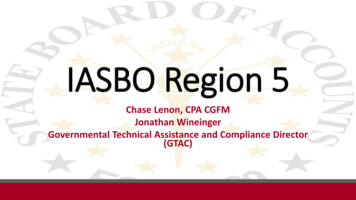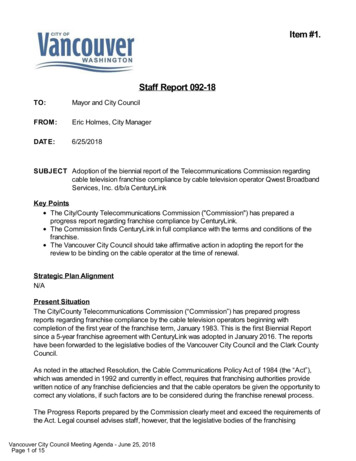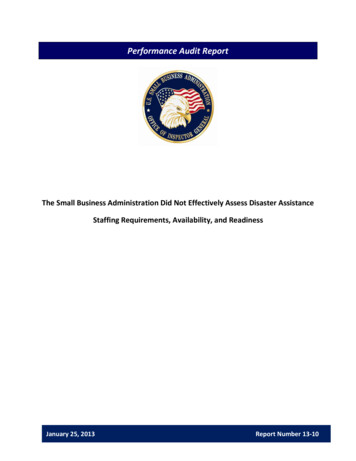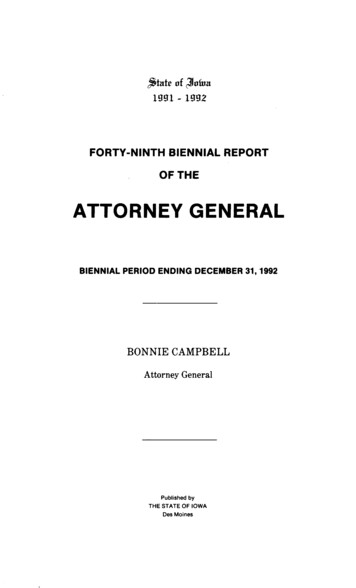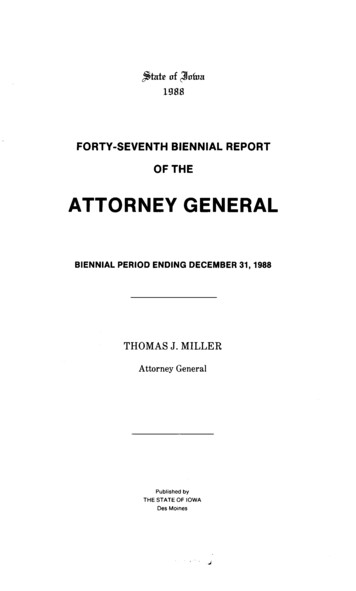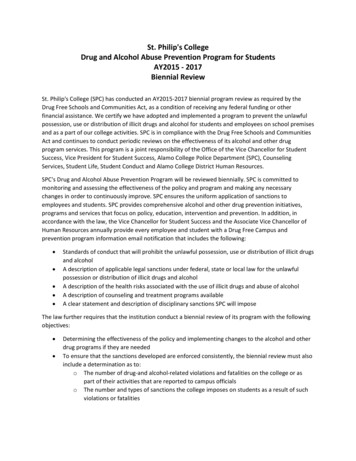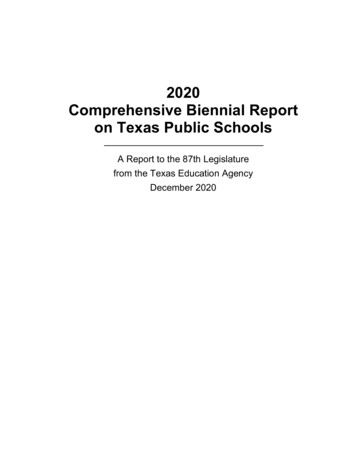
Transcription
2020Comprehensive Biennial Reporton Texas Public SchoolsA Report to the 87th Legislaturefrom the Texas Education AgencyDecember 2020
Submitted to the Governor, Lieutenant Governor, Speaker of the House of Representatives, andMembers of the 87th Texas Legislature.The 2020 Comprehensive Biennial Report on Texas Public Schools describes the status of Texas publiceducation, as required by §39.332 of the Texas Education Code. The report, available on the Texas EducationAgency (TEA) website at rt-on-texas-public-schools, contains 16 chapters on the following topics: state progress on academic performance indicators;student performance on state assessments;performance of students at risk of dropping out of school;students in disciplinary alternative education settings;secondary school graduates and dropouts;grade-level retention of students;district and campus performance in meeting state accountability standards;status of the curriculum;charter schools and waivers;school district expenditures and staff hours used for direct instructional activities;district reporting requirements;TEA funds and expenditures;performance of open-enrollment charters in comparison to school districts;character education programs;student health and physical activity; andFoundation High School Program endorsements.
2020ComprehensiveBiennial Report onTexas Public SchoolsA Report to the 87th Legislaturefrom the Texas Education AgencyDecember 2020
Texas Education AgencyMike Morath, Commissioner of EducationJeff Cottrill, Deputy Commissioner of Governance and AccountabilityAdditional AcknowledgmentsSpecial thanks to all Texas Education Agency staff who contributed to this report.Citation. Texas Education Agency. (2020). 2020 comprehensive biennial report on Texas publicschools (Document No. GE21 601 04). Austin, TX: Author.For general information about this report, contact the Texas Education Agency Division of Researchand Analysis at (512) 475-3523 or the Office of Governance and Accountability at (512) 463-8934.For additional information on specific issues, contact the agency staff listed at the end of eachchapter. This report is available on the Texas Education Agency website at rt-on-texas-publicschools.Copyright Notice. The materials are copyrighted and trademarked as the property of the Texas EducationAgency (TEA) and may not be reproduced without the express written permission of TEA, except under the followingconditions: (1) Texas public school districts, charter schools, and Education Service Centers may reproduce and usecopies of the Materials and Related Materials for the districts' and schools' educational use without obtaining permissionfrom TEA; (2) residents of the state of Texas may reproduce and use copies of the Materials and Related Materialsfor individual personal use only without obtaining written permission of TEA; (3) any portion reproduced must bereproduced in its entirety and remain unedited, unaltered and unchanged in any way; and (4) no monetary charge canbe made for the reproduced materials or any document containing them; however, a reasonable charge to cover onlythe cost of reproduction and distribution may be charged. Private entities or persons located in Texas that are notTexas public school districts, Texas Education Service Centers, or Texas charter schools or any entity, whether publicor private, educational or non-educational, located outside the state of Texas MUST obtain written approval from TEAand will be required to enter into a license agreement that may involve the payment of a licensing fee or a royalty. Forinformation contact: Copyrights Office, Texas Education Agency, 1701 N. Congress Ave., Austin, TX 78701-1494;phone 512-463-9041; email: Copyrights@tea.state.tx.us.OnTRACK for College Readiness , Texas Assessment of Knowledge and Skills (TAKS ), State Assessments ofAcademic Readiness (STAAR ), and studentGPS are either registered trademarks or trademarks of the TexasEducation Agency. Advanced Placement Program , AP , and SAT are registered trademarks of the College EntranceExamination Board. ACT Assessment is a registered trademark of the ACT, Inc. Fitnessgram is a registered trademarkof The Cooper Institute. Career Clusters is a registered trademark of the National Association of State Directors ofCareer Technical Education Consortium. Other product and company names mentioned in this report may be thetrademarks of their respective owners.ii2020 Comprehensive Biennial Report on Texas Public Schools
Contents1.Performance Indicators .12.Student Performance .573.Performance of Students At Risk of Dropping Out of School.1074.Disciplinary Alternative Education Programs .1215.Graduates and Dropouts .1296.Grade-Level Retention .1577.District and Campus Performance .1758.Status of the Curriculum .2619.Charter Schools and Waivers .28310.Expenditures and Staff Hours for Direct Instructional Activities .28911.District Reporting Requirements .29112.Agency Funds and Expenditures .29713.Performance of Open-Enrollment Charters .30114.Character Education .30915.Student Health and Physical Activity .31116.Foundation High School Program Endorsements .3172020 Comprehensive Biennial Report on Texas Public Schoolsiii
iv2020 Comprehensive Biennial Report on Texas Public Schools
Chapter 1.Performance IndicatorsThis chapter of the 2020 Comprehensive Biennial Report on Texas Public Schools presents the progressthe state is making on the performance indicators established in Texas law. These indicators were presented inAcademic Excellence Indicator System (AEIS) reports from 1990-91 to 2011-12. In the 2012-13 school year,the AEIS was renamed the Texas Academic Performance Report (TAPR) to reflect changes in legislation.Detailed analyses of three key performance indicators can be found in Chapters 2 and 5 of this report.Chapter 2 presents State of Texas Assessments of Academic Readiness (STAAR) results, and Chapter 5presents graduation rates and dropout rates.This chapter presents results for other measures and indicators presented in the TAPR (beginning onpage 6) that were used in state accountability domain calculations and in distinction designation calculations,including the following: college, career, and military readiness (CCMR); student progress; economically disadvantaged percentage; Advanced Placement (AP)/International Baccalaureate (IB) results; SAT/ACT results; advanced course/dual enrollment completion; English language proficiency; attendance rate; and profile information on students, programs, and staff.College, Career, and Military ReadinessThe CCMR component of the Student Achievement domain measures graduates' preparedness forcollege, the workforce, or the military. Annual graduates demonstrate college, career, or military readiness inany one of the following ways. Meet Texas Success Initiative (TSI) criteria in English language arts (ELA)/reading and mathematics.A graduate meeting the TSI college readiness standards in both ELA/reading and mathematics;specifically, meeting the college-ready criteria on the TSI assessment, SAT, or ACT, or bysuccessfully completing and earning credit for a college prep course as defined in Texas EducationNote. The STAAR results shown in the TAPR state performance report (beginning on page 6) differ by 1 or 2 percentage points from those reported inChapter 2 of this report. The TAPR indicators, which form the basis for the state accountability system, reflect the performance of only those studentswho were enrolled in the same districts as of October of each school year. This ensures that accountability ratings are based only on the performanceof students who have been in the same districts for most of the academic year. Chapter 2 contains the results for all students who took the STAAR in thespring of each year, regardless of their enrollment status the previous October.2020 Comprehensive Biennial Report on Texas Public Schools1
Code §28.014, in both ELA and mathematics. The assessment results considered include TSIassessments through October 2019, SAT, and ACT. A graduate must meet the TSI requirement forboth reading and mathematics but does not necessarily need to meet them on the same assessment.For example, a graduate may meet the TSI criteria for college readiness in ELA/reading on the SATand complete and earn credit for a college prep course in mathematics. Meet criteria on AP/IB examination. A graduate meeting the criterion score on an AP or IBexamination in any subject area. Criterion score is 3 or more for AP and 4 or more for IB. Earn dual course credits. A graduate completing and earning credit for at least three credit hours inELA or mathematics or at least nine credit hours in any subject. Enlist in the armed forces. A graduate enlisting in the U.S. Army, Navy, Air Force, Coast Guard, orMarines. Earn an industry-based certification. A graduate earning an industry-based certification under Title 19of the Texas Administrative Code §74.1003. Earn an associate's degree. A graduate earning an associate's degree while in high school. Graduate with completed individualized education program (IEP) and workforce readiness.A graduate receiving a graduation type code of 04, 05, 54, or 55, which indicates the student hascompleted his or her IEP and either has demonstrated self-employment with self-help skills tomaintain employment or has demonstrated mastery of specific employability and self-help skillsthat do not require public school services. Graduate under an advanced degree plan and be identified as a student currently receiving specialeducation services. A graduate who is identified as receiving special education services duringthe year of graduation and whose graduation plan type is identified as the Recommended HighSchool Plan (RHSP), Distinguished Achievement Plan (DAP), Foundation High School Planwith an Endorsement (FHSP-E), or Foundation High School Plan with a distinguished level ofachievement (FHSP-DLA). Earn a Level I or Level II certificate. A graduate earning a Level I or Level II certificate in anyworkforce education area. Career and technical education (CTE) coherent sequence coursework aligned with industry-basedcertifications. A CTE coherent sequence graduate who has completed and received credit for at leastone CTE course aligned with an industry-based certification. This indicator awards one-half pointonly for graduates who have met no other CCMR indicator. These graduates receive one-half pointcredit for coursework completed toward an industry-based certification.For the class of 2019, 61 percent of graduates were considered college ready in reading, and 49 percentwere considered college ready in mathematics. Overall for the class of 2019, 44 percent were consideredcollege ready in both subjects.For the class of 2018, 58 percent of graduates were considered college ready in reading, 46 percent wereconsidered college ready in mathematics, and 42 percent were considered college ready in both subjects.22020 Comprehensive Biennial Report on Texas Public Schools
Student ProgressThe STAAR progress measure indicates the amount of improvement or growth a student has made fromyear to year. For STAAR assessments (with or without accommodations), progress is measured as a student'sgain score, the difference between the scaled score a student achieved in the prior year and the scaled score astudent achieved in the current year. Individual student progress is then categorized as Limited, Expected, orAccelerated. If a student's progress measure is Expected, he or she Met growth expectations. If the student'sprogress measure is Accelerated, he or she Exceeded growth expectations.For STAAR Alternate 2 assessments, the progress measure is based on a student's stage change fromthe prior year to the current year. A student's stage for each year is determined by the student's scaled scoreachieved on the assessment. The student's stages of performance from the prior year and the current year arethen compared to assign the student a progress indicator, which is a determination of whether the progressmade is sufficient to designate the student as having Met or Exceeded growth expectations.In 2019, STAAR progress measure results were used in the School Progress, Part A: Academic Growthand Closing the Gaps domain calculations. The School Progress, Part A calculation credited districts andcampuses with one point for results that Met or Exceeded growth expectations, while results that maintainedproficiency but Did Not Meet growth expectations earned one-half point. STAAR progress measure resultswere also used in the Academic Achievement in English Language Arts/Reading, Academic Achievement inMathematics, Top 25 Percent: Comparative Academic Growth, and Top 25 Percent: Comparative Closing theGaps distinction designation calculations.In the 2019 ratings cycle: 62 percent of tests Met or Exceeded progress, and 20 percent Exceeded progressin reading; and 64 percent of tests Met or Exceeded progress, and 22 percent Exceeded progress inmathematics.Economically Disadvantaged PercentageThe economically disadvantaged percentage shows the percentage of students eligible for freeor reduced-price lunch or eligible for other public assistance as reported in the Texas Student DataSystem/Public Education Information Management System (TSDS/PEIMS) fall snapshot. Statewide, theeconomically disadvantaged rate in 2019-20 (60.3%) decreased slightly from the rate (60.6%) in 2018-19.The economically disadvantaged percentage was used in the School Progress, Part B: Relative Performancedomain and to construct campus comparison groups, which are used to award distinction designations.Advanced Placement and International Baccalaureate ResultsHigh school students who take the College Board's Advanced Placement (AP) or the InternationalBaccalaureate Organization's International Baccalaureate (IB) examinations may receive advanced placementor course credit, or both, upon entering college. Generally, colleges award credit or advanced placement forscores at or above 3 on AP examinations and 4 on IB examinations. AP/IB participation and performancewere evaluated for distinction designations in ELA/reading, mathematics, science, and social studies, and for2020 Comprehensive Biennial Report on Texas Public Schools3
the postsecondary readiness distinction designation. AP/IB course completion results were also an indicator inthe CCMR components of the Student Achievement and the Closing the Gaps domains.Statewide, the percentage of 11th and 12th graders taking at least one AP or IB examination was25.8 percent for the class of 2018 and 25.2 percent for the class of 2019. The percentage of 11th and12th graders with at least one score at or above criterion decreased slightly statewide from 13.1 percentfor the class of 2018 to 12.8 percent for the class of 2019.SAT/ACT ResultsThe TAPR presents participation and performance results for the SAT, published by the College Board,and the ACT, published by ACT, Inc. SAT and ACT results were used in determining distinction designationsfor academic achievement in ELA/reading, mathematics, science, and postsecondary readiness. SAT andACT results were also an indicator in the CCMR components of the Student Achievement and the Closingthe Gaps domains.The percentage of graduates who took either the SAT or the ACT increased slightly from 74.6 percent forthe class of 2018 to 75.0 percent for the class of 2019. Of the class of 2019 examinees, 36.1 percent scored ator above criterion on either test (a score of 480 on SAT evidence-based reading and writing or 19 on ACTEnglish and an ACT composite score of 23 and 530 on SAT mathematics or 19 on ACT mathematics and anACT composite score of 23), a slight decrease from 37.9 percent for the class of 2018.The average SAT total score (evidence-based reading and writing, plus mathematics) for the class of 2019was 1027, a slight decrease from 1036 for the class of 2018. The average ACT composite score for the classof 2019 was 20.6, the same as for the class of 2018.Advanced Course/Dual-Credit CompletionThe percentage of students completing advanced/dual-credit courses is based on the number of studentswho complete and receive credit for at least one advanced or dual-credit course. This data is available forGrades 9-12 and Grades 11-12. Advanced courses include AP courses, IB courses, dual-credit courses forwhich students can earn both high school and college credit, and other courses designated as academicallyadvanced. Course completion information is reported by districts through TSDS/PEIMS after the close of theschool year. For 2018 ratings, these results were used in determining the distinction designations for academicachievement in ELA/reading, mathematics, science, social studies, and postsecondary readiness. Completingand earning at least three credit hours in ELA or mathematics or at least nine credit hours in any subject wasalso an indicator in the CCMR components of the Student Achievement and the Closing the Gaps domains.In 2019, the most recent year for which data were available, 66 percent of students in Grades 11-12completed at least one advanced course, an increase from 65 percent in 2018. Across racial/ethnic groupsin 2019, percentages of students completing advanced courses ranged from 55 percent for African Americanstudents to 86 percent for Asian students. Between 2018 and 2019, the percentages of students completingadvanced courses increased or remained stable for students in all racial/ethnic groups, and for students42020 Comprehensive Biennial Report on Texas Public Schools
identified as economically disadvantaged, as at-risk, as being served in special education programs, and asEnglish learners.English Language ProficiencyThe English Language Proficiency (ELP) component measures an English learner's (EL's) progresstoward achieving English language proficiency. The ELP component evaluates the Texas English LanguageProficiency Assessment System (TELPAS) results for Grades K-12. A student is considered to have madeprogress if the student advances by at least one score of the composite rating from the prior year to thecurrent year or if the student's result is Advanced High. Current ELs are the only students evaluated in thiscomponent. The 2019 ELP component evaluated TELPAS results from 2018-19 and 2017-18. Englishlanguage proficiency was used in the Closing the Gaps domain calculations. Statewide, 36 percent of ELstudents showed progress toward achieving English language proficiency in 2019.Attendance RateAttendance rates are calculated for students in Grades 1 through 12 in all Texas public schools. Theattendance rate indicator applies to all four subject areas (ELA/reading, mathematics, science, and socialstudies) distinction designations. Statewide, the attendance rate in 2018-19 was 95.4 percent, the same asin 2017-18.Profile InformationIn addition to performance data, the TAPR provides descriptive statistics on a variety of student, program,and staff data.Agency Contact PersonsFor more information about the Texas Academic Performance Report indicators, contact Jeff Cottrill,Deputy Commissioner of Governance and Accountability, (512) 463-8934; or Jamie Crowe, PerformanceReporting, (512) 463-9704.Other Sources of InformationTexas Academic Performance Reports and profiles for each public school district and campus areavailable from each district and on the Texas Education Agency website at 0 Comprehensive Biennial Report on Texas Public Schools5
62020 Comprehensive Biennial Report on Texas Public Schools
2020 Comprehensive Biennial Report on Texas Public Schools7
82020 Comprehensive Biennial Report on Texas Public Schools
2020 Comprehensive Biennial Report on Texas Public Schools9
102020 Comprehensive Biennial Report on Texas Public Schools
2020 Comprehensive Biennial Report on Texas Public Schools11
122020 Comprehensive Biennial Report on Texas Public Schools
2020 Comprehensive Biennial Report on Texas Public Schools13
142020 Comprehensive Biennial Report on Texas Public Schools
2020 Comprehensive Biennial Report on Texas Public Schools15
162020 Comprehensive Biennial Report on Texas Public Schools
2020 Comprehensive Biennial Report on Texas Public Schools17
182020 Comprehensive Biennial Report on Texas Public Schools
2020 Comprehensive Biennial Report on Texas Public Schools19
202020 Comprehensive Biennial Report on Texas Public Schools
2020 Comprehensive Biennial Report on Texas Public Schools21
222020 Comprehensive Biennial Report on Texas Public Schools
2020 Comprehensive Biennial Report on Texas Public Schools23
242020 Comprehensive Biennial Report on Texas Public Schools
2020 Comprehensive Biennial Report on Texas Public Schools25
262020 Comprehensive Biennial Report on Texas Public Schools
2020 Comprehensive Biennial Report on Texas Public Schools27
282020 Comprehensive Biennial Report on Texas Public Schools
2020 Comprehensive Biennial Report on Texas Public Schools29
302020 Comprehensive Biennial Report on Texas Public Schools
2020 Comprehensive Biennial Report on Texas Public Schools31
322020 Comprehensive Biennial Report on Texas Public Schools
2020 Comprehensive Biennial Report on Texas Public Schools33
342020 Comprehensive Biennial Report on Texas Public Schools
2020 Comprehensive Biennial Report on Texas Public Schools35
362020 Comprehensive Biennial Report on Texas Public Schools
2020 Comprehensive Biennial Report on Texas Public Schools37
382020 Comprehensive Biennial Report on Texas Public Schools
2020 Comprehensive Biennial Report on Texas Public Schools39
402020 Comprehensive Biennial Report on Texas Public Schools
2020 Comprehensive Biennial Report on Texas Public Schools41
422020 Comprehensive Biennial Report on Texas Public Schools
2020 Comprehensive Biennial Report on Texas Public Schools43
442020 Comprehensive Biennial Report on Texas Public Schools
2020 Comprehensive Biennial Report on Texas Public Schools45
462020 Comprehensive Biennial Report on Texas Public Schools
2020 Comprehensive Biennial Report on Texas Public Schools47
482020 Comprehensive Biennial Report on Texas Public Schools
2020 Comprehensive Biennial Report on Texas Public Schools49
502020 Comprehensive Biennial Report on Texas Public Schools
2020 Comprehensive Biennial Report on Texas Public Schools51
522020 Comprehensive Biennial Report on Texas Public Schools
2020 Comprehensive Biennial Report on Texas Public Schools53
542020 Comprehensive Biennial Report on Texas Public Schools
2020 Comprehensive Biennial Report on Texas Public Schools55
562020 Comprehensive Biennial Report on Texas Public Schools
Chapter 2.Student PerformanceThis chapter provides an overview of student performance on statewide assessments, including the Stateof Texas Assessments of Academic Readiness (STAAR), STAAR Spanish, STAAR Alternate 2, the TexasEnglish Language Proficiency Assessment System (TELPAS), and TELPAS Alternate. Because of theCOVID-19 pandemic, the STAAR and STAAR Alternate 2 assessments were canceled for spring 2020 andTELPAS and TELPAS Alternate were to be completed on an optional basis. As a result, state assessmentresults for 2020 are not presented in this report.STAAR is an assessment designed to measure the extent to which students have learned and are able toapply the knowledge and skills outlined in the Texas Essential Knowledge and Skills (TEKS), the statemandated curriculum. One important function of STAAR is to gauge how well schools and teachers arepreparing students academically. The test is specifically designed to measure individual student progress inrelation to content that is directly tied to the TEKS. Every STAAR question is directly aligned to the TEKScurrently in effect for the grade and subject or the course being assessed. Students are tested in mathematicsand reading in Grades 3-8, writing in Grades 4 and 7, science in Grades 5 and 8, and social studies in Grade 8(Table 2.1). In general, students must pass five STAAR end-of-course (EOC) assessments—Algebra I,English I, English II, Biology, and U.S. History—to earn a high school diploma from a Texas public schoolor open-enrollment charter school (Texas Education Code §39.025). A student who fails a STAAR EOCassessment for no more than two of five courses can still receive a diploma if he or she is determined to bequalified to graduate by an individual graduation committee (Title 19 of the Texas Administrative Code§101.3022).Table 2.1State Assessments, 2019 and 2020Subject AreaReadingWritingMathematicsScienceSocial StudiesGradeK-12-12a3STAARSTAAR SpaSTAAR Alt 2bSTAARSTAAR SpSTAAR Alt 2State of Texas Assessments of Academic Readiness (STAAR)Grade45678STAARSTAARSTAARSTAARSTAARSTAAR SpSTAAR SpSTAAR Alt 2 STAAR Alt 2 STAAR Alt 2STAAR Alt 2 STAAR Alt 2STAARSTAARSTAAR SpSTAAR Alt 2STAAR Alt 2STAARSTAARSTAARSTAARSTAARSTAAR SpSTAAR SpSTAAR Alt 2 STAAR Alt 2 STAAR Alt 2STAAR Alt 2 STAAR Alt 2STAARSTAARSTAAR SpSTAAR Alt 2STAAR Alt 2STAARSTAAR Alt 2End-of-CourseEnglish IEnglish IISTAARSTAARSTAAR Alt 2 STAAR Alt 2Algebra ISTAARSTAAR Alt 2BiologySTAARSTAAR Alt 2U.S. HistorySTAARSTAAR Alt 2Texas English Language Proficiency Assessment System (TELPAS)TELPAS assessments in four language domains: listening, speaking, reading, and writing.TELPAS and TELPAS Altc assessments in four language domains: listening, speaking, reading, and writing.STAAR Spanish. bSTAAR Alternate 2. cTELPAS Alternate.2020 Comprehensive Biennial Report on Texas Public Schools57
STAAR Spanish assessments are offered for mathematics and reading in Grades 3-5, writing in Grade 4,and science in Grade 5. STAAR Spanish assessments are designed to measure the academic skills of studentswho receive their academic instruction primarily in Spanish. STAAR and STAAR Spanish assess the sameTEKS content standards and have the same test blueprints.STAAR Alternate 2 is an assessment based on alternate academic achievement standards and is designedfor students receiving special education services who have the most significant cognitive disabilities and whomeet the specific participation requirements for the assessment. STAAR Alternate 2 is designed to meet stateand federal requirements under the Elementary and Secondary Education Act (ESEA), as amended by theEvery Student Succeeds Act (ESSA), and is offered in the same grades/subjects and courses assessed bySTAAR.TELPAS measures the annual progress students identified as English learners (ELs) in kindergartenthrough Grade 12 make in learning English in four language domains: listening, speaking, reading, andwriting. For each language domain, TELPAS measures four levels, or stages, of increasing English languageproficiency: beginning, intermediate, advanced, and advanced high. TELPAS measures learning in alignmentwith the English Language Proficiency Standards (ELPS), which are part of the TEKS. The ELPS outline theinstruction ELs must receive to support their ability to develop academic English language proficiency andacquire challenging academic knowledge and skills. The ELPS are composed of second language acquisitionknowledge and skills that ELs are expected to learn, as well as proficiency level descriptors (PLDs)characterizing the four English language proficiency levels reported in Texas. TELPAS is designed to meetstate requirements and federal requirements under ESEA, as amended by ESSA.Under ESSA, the state is required to administer an alternate assessment for ELs with the most significantcognitive disabilities who cannot participate in the general English language proficiency assessment, evenwith allowable accommodations. TELPAS Alternate is designed to evaluate students in Grades 2-12 who areidentified in the Public Education Information Management System (PEIMS) as limited English proficientand also have significant cognitive disabilities. TELPAS Alternate is a holistic inventory aligned to the ELPS;however, it is based on alternate PLDs that were created to address the specific access
college, the workforce, or the military. Annual graduates demonstrate college, career, or military readiness in any one of the following ways. Meet Texas Success Initiative (TSI) criteria in English language arts (ELA)/reading and mathematics. A graduate meeting the TSI college readiness standards in both ELA/reading and mathematics;
